To keep your home fuel cell running smoothly in cold weather, you'll need these essential tricks. Insulate the housing and maintain ideal temperature. Use antifreeze in the cooling system and install wind barriers for protection. Monitor fuel quality closely and conduct regular maintenance checks. Don't forget to have backup heat sources ready. Optimize your fuel cell's placement and implement smart energy management strategies. Prevent condensation buildup and choose appropriate barrier materials. By following these tips, you'll guarantee your fuel cell operates efficiently even in the harshest winter conditions. Discover more ways to maximize your fuel cell's cold-weather performance below.
Insulate Fuel Cell Housing
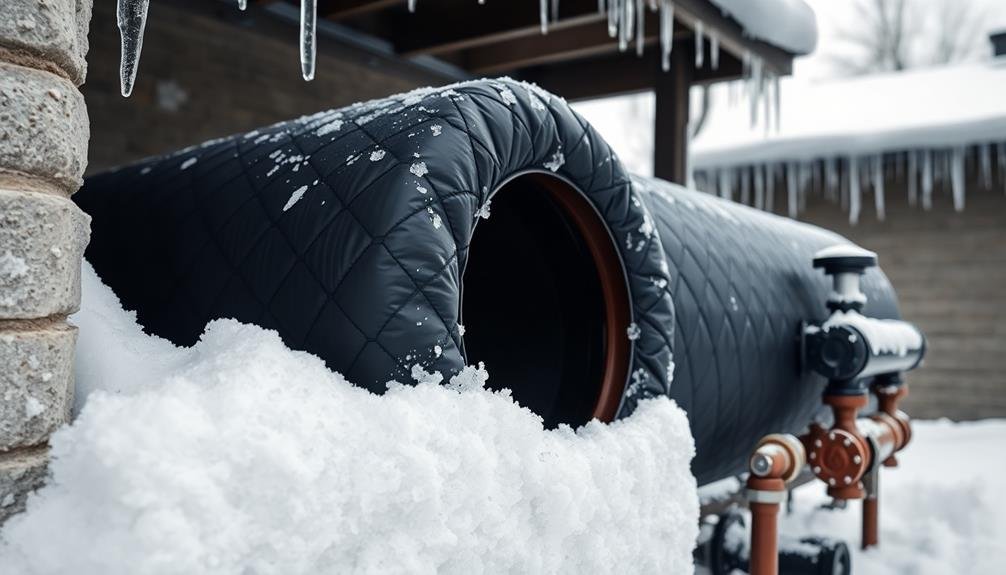
Winter's chill can wreak havoc on your home fuel cell's performance. To combat this, insulating your fuel cell housing is vital. Start by inspecting the existing insulation for any gaps or wear. Replace or add insulation as needed, using high-quality materials designed for extreme temperatures.
Focus on key areas like the outer casing, pipes, and connections. Use foam insulation sleeves for pipes and wrap the main unit with a custom-fit insulation blanket. Don't forget to insulate valves and joints, as these are often overlooked weak points.
For added protection, consider installing a weather-resistant enclosure around your fuel cell system. Confirm proper ventilation remains intact, as fuel cells require airflow for peak function. Use breathable insulation materials that prevent moisture buildup while retaining heat.
Install a small heater within the housing to maintain a consistent temperature during extreme cold spells. Regularly monitor the insulation's condition and performance. Replace damaged sections promptly to maintain efficiency.
Maintain Optimal Operating Temperature
To maintain your fuel cell's ideal operating temperature, you'll need to focus on insulation and thermal management.
You can wrap the entire fuel cell system in insulating materials to prevent heat loss during cold weather.
Additionally, you should implement thermal management techniques, such as using heat exchangers or temperature-controlled coolant systems, to regulate the fuel cell's internal temperature and guarantee efficient operation.
Insulate Fuel Cell System
Consistently maintaining ideal operating temperatures is essential for your home fuel cell system's efficiency in cold weather. To achieve this, proper insulation is vital.
Start by inspecting your fuel cell's existing insulation and replace any damaged or worn-out materials. Use high-quality, heat-resistant insulation specifically designed for fuel cell systems to wrap the entire unit, paying special attention to pipes and connections.
Consider installing a custom-fit insulation jacket for your fuel cell. These jackets are tailored to fit specific models and provide excellent thermal protection.
Don't forget to insulate the fuel supply lines and exhaust pipes, as these can be significant sources of heat loss.
For added protection, create a dedicated, insulated enclosure for your fuel cell system. This can be a small shed or a partitioned area in your garage or basement.
Make sure the enclosure has proper ventilation to prevent overheating and allow for safe operation.
Lastly, monitor the temperature inside the insulated area regularly. Install a thermometer and adjust your insulation strategy as needed to maintain ideal operating conditions.
Use Thermal Management Techniques
Effective thermal management is essential for your home fuel cell's ideal performance in cold weather. You'll need to maintain the system's best operating temperature to guarantee efficiency and longevity. Start by implementing a heat recovery system that captures waste heat from the fuel cell process and redirects it to preheat incoming reactants. This not only improves overall efficiency but also helps maintain internal temperatures.
Consider installing a supplementary heating element for extremely cold conditions. It can provide additional warmth during startup or when ambient temperatures drop considerably. You should also use smart temperature sensors and controls to monitor and adjust the system's temperature in real-time, preventing both overheating and freezing.
| Technique | Benefit | Emotion |
|---|---|---|
| Heat recovery | Improved efficiency | Satisfaction |
| Supplementary heating | Reliable operation | Reassurance |
| Smart controls | Precise management | Confidence |
Don't forget to properly insulate coolant lines and use antifreeze solutions to prevent freezing in the cooling system. By employing these thermal management techniques, you'll guarantee your home fuel cell operates smoothly and efficiently, even in the harshest winter conditions.
Use Antifreeze in Cooling System
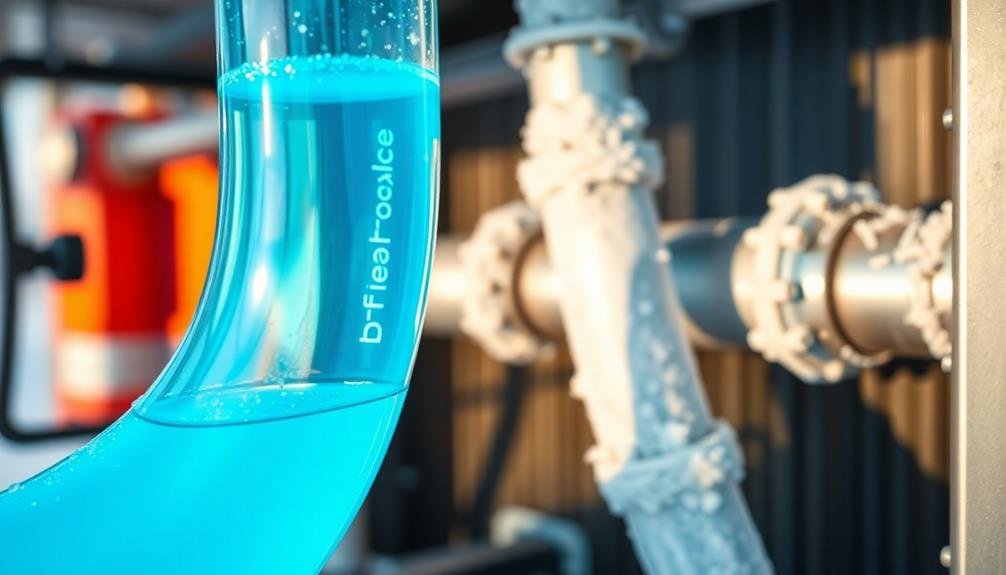
During frigid temperatures, adding antifreeze to your home fuel cell's cooling system is vital. This simple step prevents the water in the cooling system from freezing, which could damage your fuel cell and disrupt its operation.
Choose an antifreeze solution that's compatible with your specific fuel cell model, as some types may contain additives that could harm the system's components.
When adding antifreeze, you'll need to adjust the mixture ratio based on the expected lowest temperatures in your area. A 50/50 mix of antifreeze and water is typically sufficient for most climates, but consult your fuel cell's manual for specific recommendations.
Remember to check the antifreeze concentration regularly, especially before winter sets in.
It's important to use distilled water when mixing antifreeze, as tap water can contain minerals that may damage your fuel cell over time.
After adding the antifreeze mixture, run the fuel cell for a short period to guarantee proper circulation throughout the system. This also helps identify any potential leaks or issues.
Don't forget to inspect the cooling system's hoses and connections for signs of wear or damage when adding antifreeze. Replace any compromised components to maintain peak performance and prevent coolant leaks.
Install Wind Barriers
When installing wind barriers for your home fuel cell, you'll want to position them strategically for maximum protection against cold gusts.
Consider placing barriers on the windward side of your fuel cell setup, typically the north or northwest in many regions.
Choose appropriate materials like sturdy fencing, dense shrubbery, or purpose-built windscreens that can withstand harsh weather while effectively reducing wind chill on your fuel cell components.
Position for Maximum Protection
Proper positioning of your home fuel cell can make all the difference in its cold-weather performance. To maximize protection, consider placing your unit on the south-facing side of your home. This location typically receives the most sunlight and warmth throughout the day, helping to maintain ideal operating temperatures.
If possible, install your fuel cell near a wall or corner where two walls meet. This configuration provides natural wind protection and reduces exposure to harsh elements. Verify there's adequate clearance around the unit for proper ventilation and maintenance access.
You'll also want to elevate your fuel cell slightly off the ground. This prevents moisture accumulation and protects against snow buildup. Use a sturdy platform or concrete pad to create a stable base.
Consider the prevailing wind direction in your area when positioning your fuel cell. Place it in a spot that's shielded from strong gusts. If necessary, create additional windbreaks using fencing, landscaping, or purpose-built structures.
Don't forget to account for potential snow drifts when choosing a location. Avoid areas where snow tends to accumulate, as this can impede airflow and reduce efficiency.
Choose Appropriate Barrier Materials
For effective wind protection, selecting the right barrier materials is essential. You'll want to choose materials that can withstand harsh weather conditions while effectively blocking wind. Reflect on factors such as durability, insulation properties, and ease of installation.
Common barrier materials include:
| Material | Pros | Cons |
|---|---|---|
| Wood fencing | Natural look, customizable | Requires maintenance |
| Metal panels | Durable, low maintenance | Can be noisy in high winds |
| Vinyl sheets | Affordable, easy to install | May crack in extreme cold |
| Stone walls | Long-lasting, excellent insulation | Expensive, labor-intensive |
| Evergreen hedges | Attractive, natural windbreak | Slow-growing, needs care |
When selecting your barrier material, think about your specific needs and local climate. If you're in an area with heavy snowfall, opt for materials that can bear the weight. For coastal regions, choose corrosion-resistant options.
Don't forget to reflect on the height of your barrier. It should be tall enough to effectively shield your fuel cell from prevailing winds. A good rule of thumb is to make the barrier at least 1.5 times the height of the object you're protecting.
Monitor Fuel Quality
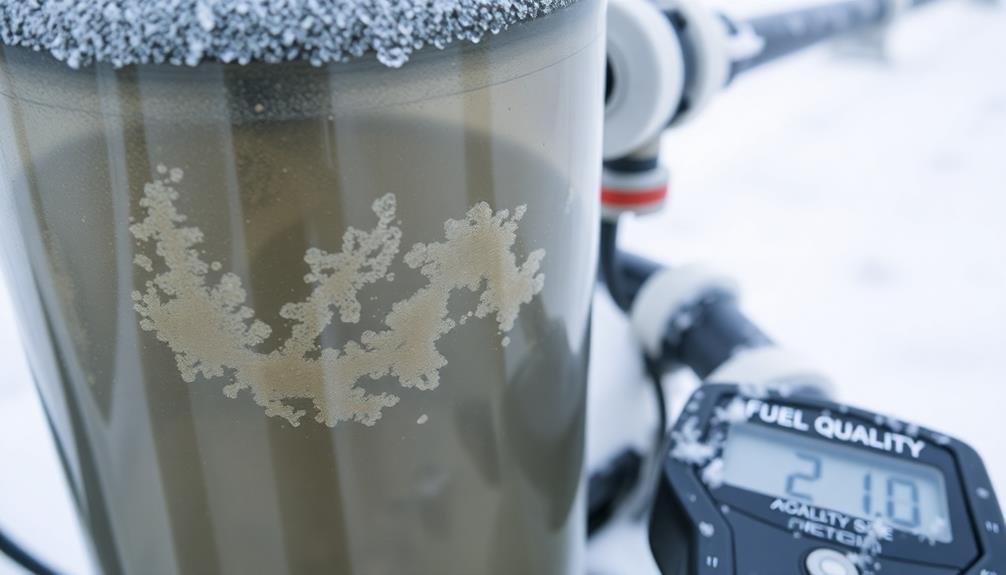
Your fuel cell's performance hinges on the quality of its fuel supply. In cold weather, it's essential to monitor fuel quality closely to guarantee peak operation.
First, check your fuel's purity regularly. Contaminants can accumulate more easily in colder temperatures, potentially clogging your system or reducing efficiency. Use a fuel analyzer to detect impurities and address them promptly.
Keep an eye on your fuel's water content, as excess moisture can freeze and damage components. Install a water separator in your fuel line and empty it frequently during cold spells.
Also, consider using winter-grade fuel with a lower freezing point to prevent fuel line blockages.
Monitor your fuel's flow rate, as cold temperatures can increase viscosity and slow fuel delivery. If you notice reduced flow, you may need to adjust your fuel pump settings or use additives to improve fluidity.
Finally, store your fuel properly. Use insulated tanks and keep them full to minimize condensation. If possible, place fuel storage in a temperature-controlled area to maintain consistent quality.
Prevent Condensation Buildup
While fuel quality is essential, managing condensation is equally important for cold-weather fuel cell performance. As temperatures drop, moisture in the air can condense inside your fuel cell system, potentially causing damage and reducing efficiency. To prevent this, you'll need to take proactive measures.
First, verify proper ventilation around your fuel cell. Good airflow helps remove excess moisture and maintains a stable temperature. You can install small fans or vents to improve circulation if needed.
Next, consider using a dehumidifier in the area where your fuel cell is located. This will help reduce overall humidity levels and minimize condensation risks.
Insulation is another key factor. Wrap exposed pipes and components with insulating materials to prevent temperature fluctuations that can lead to condensation.
You should also regularly inspect your fuel cell for signs of moisture buildup, such as water droplets or frost. If you notice any, dry the affected areas immediately and address the underlying cause.
Lastly, maintain a consistent operating temperature for your fuel cell. Sudden temperature changes can cause rapid condensation, so try to keep the environment stable.
Regular Cold-Weather Maintenance Checks
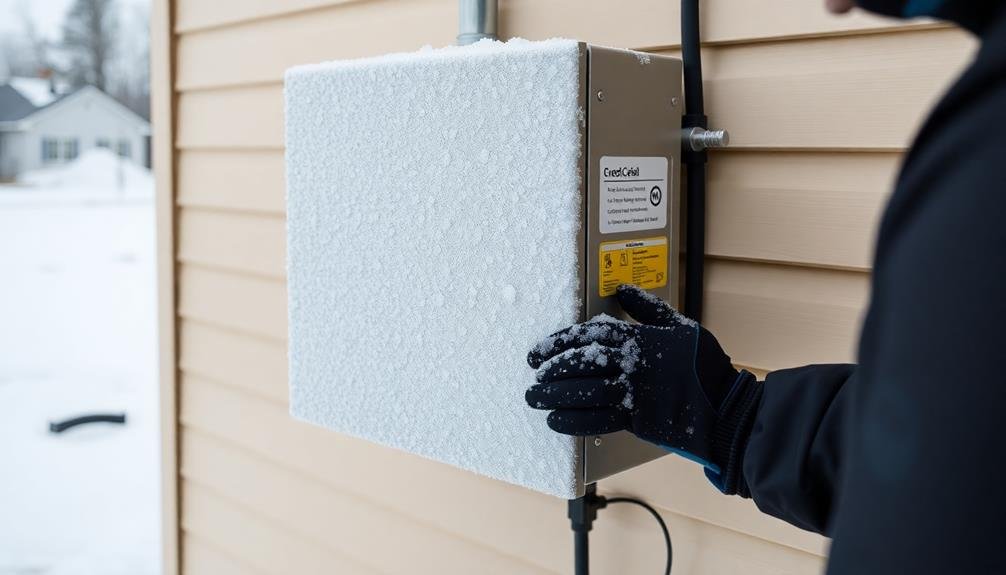
Winter's chill demands vigilance when it comes to your home fuel cell. Regular cold-weather maintenance checks are essential to guarantee peak performance and longevity.
Start by inspecting the fuel cell's exterior for any signs of damage or wear, paying close attention to seals and connections that might be affected by freezing temperatures.
Check the air intake and exhaust systems for blockages caused by snow or ice buildup. Clear any obstructions to maintain proper airflow and prevent system inefficiencies.
Monitor the fuel cell's internal temperature gauges regularly, making certain they stay within the manufacturer's recommended range.
Examine the coolant levels and consistency, topping up if necessary with a winter-grade antifreeze solution.
Inspect all pipes and hoses for cracks or leaks, which can worsen in cold conditions. Don't forget to test the backup battery system, as it's vital during potential power outages.
Review your fuel cell's insulation, particularly around exposed components. Consider adding extra insulation if needed to protect against extreme cold.
Employ Backup Heat Sources
In spite of your fuel cell's reliability, employing backup heat sources is vital for cold-weather preparedness.
Even the most robust systems can face challenges during extreme weather, so it's important to have alternatives in place.
Consider installing a small propane or natural gas heater as your primary backup.
These units are efficient, relatively inexpensive, and can quickly warm up specific areas of your home.
Make sure you've got an adequate fuel supply on hand and that the heater is properly vented.
Electric space heaters are another viable option.
They're portable and don't require fuel storage, but they can be costly to operate and may strain your electrical system.
If you choose this route, opt for models with built-in safety features like tip-over protection and automatic shut-off.
A wood-burning stove or fireplace can serve as both a heat source and a cozy focal point.
They're reliable during power outages but require regular maintenance and a steady supply of dry firewood.
Don't forget about passive heating methods.
Use heavy curtains, draft stoppers, and proper insulation to retain heat.
In a pinch, you can create a warm microclimate by gathering in a single room with your backup heat source.
Optimize Fuel Cell Placement
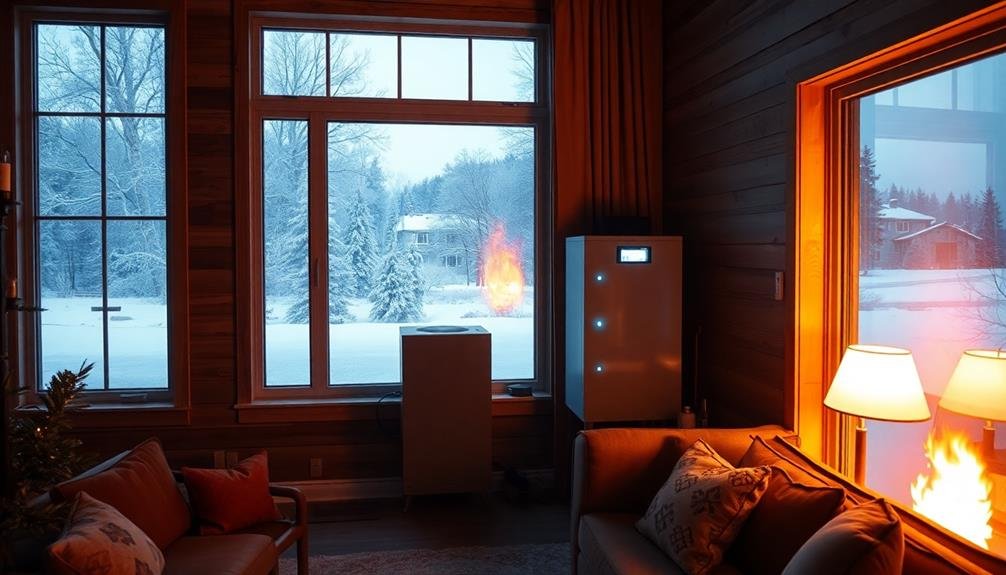
When placing your home fuel cell, consider sheltered outdoor locations that protect it from harsh weather while ensuring proper ventilation.
If you're opting for indoor installation, carefully evaluate ventilation requirements to maintain safety and efficiency.
Position the fuel cell close to existing utilities for easier connection and maintenance, reducing potential complications during cold weather operation.
Sheltered Outdoor Locations
Where should you place your home fuel cell to protect it from harsh winter conditions? Consider sheltered outdoor locations that offer protection from the elements while maintaining proper ventilation. Look for spots near your home that are shielded from strong winds and direct precipitation.
A south-facing wall of your house can provide an ideal location, as it receives more sunlight and warmth during winter months. Alternatively, consider placing your fuel cell under an existing overhang or creating a custom shelter. Ascertain the area is easily accessible for maintenance and has proper drainage to prevent water accumulation.
Here's a quick comparison of potential sheltered outdoor locations:
| Location | Wind Protection | Sun Exposure | Accessibility | Drainage |
|---|---|---|---|---|
| South-facing wall | Good | Excellent | Very good | Good |
| Under overhang | Excellent | Fair | Good | Fair |
| Custom shelter | Excellent | Variable | Excellent | Excellent |
| Near garage | Good | Variable | Excellent | Good |
When selecting a location, consider your specific property layout and local climate conditions. Verify the chosen spot complies with local building codes and manufacturer recommendations for safe fuel cell operation.
Indoor Ventilation Considerations
Regarding indoor placement for your home fuel cell, proper ventilation becomes essential for safe and efficient operation.
You'll need to guarantee adequate airflow to prevent the buildup of heat and exhaust gases. Choose a well-ventilated area, such as a basement or utility room, with access to exterior walls for venting.
Install carbon monoxide detectors near the fuel cell and in adjacent living spaces. You'll want to create a dedicated ventilation system, including intake and exhaust vents. The intake vent should draw fresh air from outside, while the exhaust vent should safely expel waste gases away from your home.
Don't forget to take into account the noise level of your fuel cell when selecting an indoor location. Opt for a spot that's away from bedrooms or living areas to minimize disturbance.
You'll also need to guarantee easy access for maintenance and repairs. Keep the area around your fuel cell clear of flammable materials and store any fuel safely away from the unit.
Regularly inspect your ventilation system to guarantee it's functioning correctly and free from obstructions. By following these guidelines, you'll create a safe and efficient indoor environment for your home fuel cell.
Proximity to Utilities
Ideal fuel cell placement hinges on proximity to utilities. You'll want to position your fuel cell close to your home's existing gas and electrical connections. This proximity reduces the need for extensive piping or wiring, minimizing heat loss and electrical resistance.
For natural gas-powered fuel cells, locate the unit near your gas meter or main gas line. This placement guarantees efficient fuel delivery and simplifies installation. If you're using propane, consider placing the fuel cell close to your propane tank or connection point.
Electrical connections are equally important. Position your fuel cell near your main electrical panel or breaker box. This proximity allows for easier integration with your home's electrical system and reduces power loss during transmission.
Don't forget about water connections. Many fuel cells require water for cooling or as part of the electrochemical process. Placing the unit near a water source or drainage point can simplify plumbing requirements and improve overall efficiency.
Lastly, consider future maintenance needs. Confirm there's enough space around the fuel cell for technicians to access and service the unit easily. This foresight will save you time and hassle in the long run.
Implement Smart Energy Management
To maximize your home fuel cell's efficiency in cold weather, implementing smart energy management is vital.
Start by installing a smart thermostat that can learn your household's habits and adjust temperatures accordingly. This will help reduce unnecessary heating when you're away or asleep.
Next, utilize zone heating to focus warmth in occupied areas. Install programmable thermostats in each room to fine-tune temperatures based on usage patterns.
Consider using thermal curtains and draft stoppers to minimize heat loss through windows and doors.
Integrate your fuel cell with a home energy management system (HEMS) to monitor and optimize power consumption. This system can prioritize energy-efficient appliances and schedule high-energy tasks during off-peak hours.
It'll also help you track your fuel cell's performance and identify potential issues early.
Don't forget to regularly maintain your fuel cell system. Clean or replace filters, check for leaks, and guarantee proper ventilation.
Consider installing a backup battery system to store excess energy for use during peak demand periods or unexpected outages.
Frequently Asked Questions
How Long Does a Home Fuel Cell Typically Last in Cold Climates?
You'll typically see your home fuel cell last 10-20 years in cold climates. However, it's essential to maintain it properly and protect it from extreme temperatures. Regular servicing and insulation can greatly extend its lifespan.
Can Fuel Cells Be Used as the Sole Power Source in Extreme Cold?
You can use fuel cells as your sole power source in extreme cold, but you'll need to take precautions. They're less efficient in low temperatures, so you'll want to insulate them well and consider backup heating systems.
What's the Minimum Temperature at Which a Home Fuel Cell Can Operate?
You'll find most home fuel cells can operate down to about 32°F (0°C). However, some advanced models work at temperatures as low as -4°F (-20°C). It's essential to check your specific unit's specifications for accurate information.
Are There Specific Fuel Types Better Suited for Cold-Weather Fuel Cell Operation?
You'll find that propane and natural gas are better suited for cold-weather fuel cell operation. They're less likely to freeze and provide consistent performance. However, you should always consult your fuel cell manufacturer for specific recommendations.
How Does Cold Weather Affect the Efficiency of a Home Fuel Cell?
Cold weather reduces your home fuel cell's efficiency. You'll notice lower power output and slower reaction rates. It's harder to maintain ideal operating temperatures, and you might experience more frequent shutdowns or longer startup times.
In Summary
You've now got the tools to keep your home fuel cell running smoothly in cold weather. Remember, it's all about preparation and maintenance. Don't forget to insulate, monitor, and protect your system. With these tricks, you'll maximize efficiency and avoid costly breakdowns. Stay proactive, and you'll enjoy reliable power even when temperatures plummet. Keep these tips handy, and you'll be ready to tackle whatever winter throws your way.

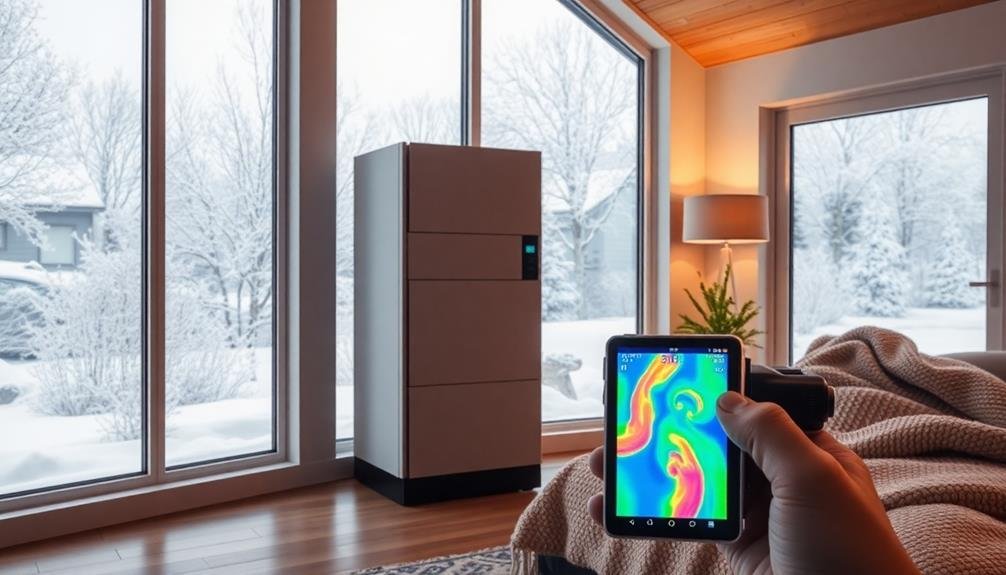



Leave a Reply